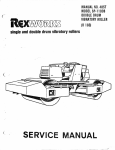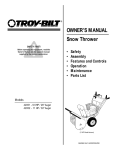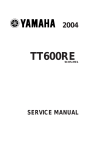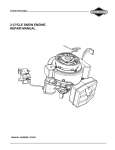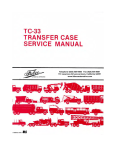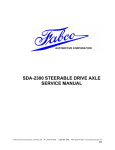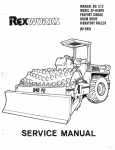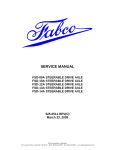Download Electia SDA-9 Specifications
Transcript
Telephone (925) 454-9500 Fax (925) 454-9501 151 Lawrence Drive, Livermore, CA 94551 www.fabcoautomotive.com TABLE OF CONTENTS I. Description and Operation A. B. C. II. General Description Operation Operation Instructions V. 2 2 2 A. B. C. D. E. Wheel Bearings Universal Joints Kingpin Bearings Differential Carrier Steering Tie Rod Ball Joints 3 3 3 4 4 Ill. Axle Adjustment A . B. C. D. E. F. G. H. IV. General Wheel Bearing Adjustment Kingpin Adjustment Steering Stop Adjustment Camber Adjustment Caster Adjustment Toe-In Adjustment Brake Adjustment 5 5 5-6 6 7 8 8 8 Steerable Drive End Disassembly A. B. C. D. E. F. G. H. I. J. K. L. M. N. O. General Precautions for Disassembly Brake Drum, Hub and Wheel Bearing Disassembly Brake and Wheel Spindle Disassembly Spindle Yoke Removal Removal of the Outboard Section of the Steerable Drive End Inner Axle Shaft Removal Lower Kingpin Bracket and Kingpin Removal Lower Kingpin Bearing Removal Upper Kingpin Removal Steering Arm Removal Upper Kingpin Removal Inner Axle Seal Removal Outer Axle Seal Removal Outer Drive Yoke Roller Bearing Removal Universal Joint Disassembly A . Choice of Cleaning Methods B . Drying and Corrosion Inhibition C . Inspection VI. Lubrication 9 Cleaning and Inspection Steerable Drive End Assembly A. General Precautions for Reassembly B. After Partial Disassembly C . Suspension Yoke Assembly D . Spindle Yoke Assembly E . Lower Kingpin Bracket Installation F . Spindle Yoke to Suspension Yoke Assembly G . Brake Assembly Installation H. Wheel Hub Assembly I. Outer Drive Yoke and Outer Drive Axle Shaft Assembly J. Universal Joint Assembly K . Brake Actuator Chamber Installation L . Steering Arm Assembly M . Tie Rod Assembly N . Final Assembly A. 10 11 B. 12 12 13 13 13 13 13 15 15 15-16 17 17 17 17 18 19 19 19 19 19 VII. Differential Carrier Removal and Installation 9 11-12 12 14 14 14 Removal of Differential Carrier from Axle Installation of Differential Carrier to Axle VIII. Torque Specifications Service Bulletin 20 20 21 22-24 PARTS MANUAL SDA SDA SDA SDA 13 13 12 16 18 21 25-32 33-40 41-47 49-55 Additional Service Manuals Single Reduction Differential Service Manual Air Brake Service Manual Hydraulic Brake Service Manual SDA-12-16-18-21-2M (12/89) —1— I. DESCRIPTION & OPERATION A. General Description The Fabco Steerable Drive Axle consists of four major assemblies. The axle housing is the structural backbone. Steerable drive ends are attached to each end of the housing. A differential carrier assembly bolts into the center of the housing. A steering connecting tie rod joins between the right and left steerable drive ends. A steering arm is provided (usually on the left steerable drive end) for connection into a vehicle’s steering system. It may be equipped with right hand or dual steering arms. B. Operation Driving forces are put into the axle at the pinion yoke on the differential carrier; they pass through the differential to the inner axle shafts and the inner drive yoke of the universal joint; they then pass into the outer drive yoke and the outer axle shaft which connects to the wheel hub and rotates the wheel. —2— When steered, the outer section of each steerable drive end turns about the kingpin centerline. The universal joint, centered on the kingpin centerline, allows driving forces to turn with the steered wheel ends. The axle is equipped with air or hydraulic brakes. The brake shoes expand to contact conventional brake drums. C. Operating Instructions In conditions where the vehicle’s rear wheels might spin, such as sand, loose dirt, mud, snow, ice or ascending grades, the front drive axle can be shifted into operation for improved traction. Engagement can be made at any vehicle speed, unless the rear wheels are spinning. Engagement is best accomplished while the engine is pulling lightly. II. LUBRICATION Recommended Lubricants LUBRICANT ABOVE 32° BELOW 32° Gear Oil MIL-L-2105 B SAE 140 MIL-L-2105 C 80W-140 MIL-L-2105 B SAE 90 MIL-L-2105 C 80W-90 Chassis Grease MIL-G-10294 MIL-G-10294 Wheel Bearing Grease NLGI Grade #2 NLGI Grade #2 Wheel Bearing Oil Use same as recommended for differential A. Wheel Bearings Wheel bearings require cleaning, inspection, packing with grease or an oil change at each brake re-line. Wheel bearings should be lubricated in accordance with the vehicle manufacturers recommendations. They may either be grease packed or oil lubricated. A ¼” pipe plug (See fig. 2) is located under the hubcap in the outer axle shaft flange. Oil filled wheel hubs should be filled to the level of this plug when it is in a position on the axle horizontal centerline. When using grease to pack the bearings, grease both inner and outer wheel bearings. In addition to greasing both inner and outer wheel bearings, be sure to grease the carrier bearing for the outer drive yoke. By removing the cross and bearing U joint and outer drive yoke, you can hand pack the outer drive yoke carrier bearing. When packing the carrier bearing be sure not to damage the outer drive yoke seal. Fig. 2 B. Universal Joints Universal joints should be lubricated at each chassis lubrication (approximately 1,000 mile intervals). Vehicles operated with the joints submerged must be lubricated at more frequent intervals. Grease the universal joints until grease seepage occurs at the caps. If grease does not seep out of all four caps, rotate universal joints 180° and reapply grease. C. Kingpin Bearings Kingpin bearings should be lubricated at each chassis lubrication (approximately 1,000 mile intervals). To ensure thorough lubrication, the front axle should be raised slightly to relieve weight. The lower kingpin lube fitting is located in the lower suspension yoke.The upper kingpin fitting is either on the front or rear of the upper kingpin bracket (See fig. 3). Fig. 3 —3— II. LUBRlCATlON D. Differential Carriers Differential carriers should have the lubricant changed at the same intervals as the rear axle on the vehicle, or at 10,000 mile intervals. Drain while lubricant is warm. Clean the magnetic drain plug when it is removed. Remove the fill plug to ensure quicker drainage. Allow housing to drain completely. Install the drain plug and fill the housing with the appropriate gear oil to the bottom of the fill plug hole. Check for leaks. SAE 140 gear oil (meeting Mil-L-2105B) is appropriate for most operating conditions. Follow the vehicle manufacturers recommendations for the rear axle and apply them to the front axle under other conditions. E. Steering Tie Rod Ball Joints Fig. 4 Steering tie rod ball joints should be lubricated every 1,000 miles with chassis lubricant (See fig. 3, Page 3.) Check the steering system at each lubrication. Inspect for loose, bent or otherwise damaged components. Careful attention to such detail is a vital safety factor. Fig. 5 Fig. 6 —4— III. AXLE ADJUSTMENT A. General C. Kingpin Adjustment 1. The front of the vehicle should be raised and properly supported. The front wheels should be taken off the axle. Adjustments may be necessary after an accident, in response to and to correct steering problems, tire wear problems or as a part of the reassembly process after a thorough inspection. 2. The lower kingpin jam nut should be loosened and the lower kingpin ball should be backed down until it stops. B. Wheel Bearing Adjustment 1. Raise the front of the vehicle with a jack and secure vehicle with jackstands of suitable capacity. 2. Remove front wheels from vehicle. 3. Remove the brake drum. (Disc style wheels only.) 3. Loosen the upper kingpin adjusting screw jam nut. Back off the adjusting screw approximately four (4) turns. 4. Place a small bottle jack under the wheel end (See fig. 6A). Raise the wheel end until the upward movement stops. By feeling the gap between the lower kingpin bracket and the suspension yoke (See fig. 6B), you will be able to determine when upward movement stops. You have now seated the upper kingpin. 4. With the end turned to full steering lock, remove the bolt and washer retaining the outer drive yoke. (See fig. 14, Page 9.) 5. Remove the two cap screws that hold the hub cap on, then proceed to remove the nuts from the outer axle shaft drive studs. 6. The flange should be loose enough to remove by hand. If not, use suitable bolts in the extractor holes to remove the outer axle shaft. (See fig. 15, Page 9.) Note: If oil is used for wheel bearing lubrication, care should be exercised to protect brake linings, etc. 7. Fig. 6A Remove the wheel bearing lock nut (See fig. 4, Page 4) and lockwasher from spindle. Loosen wheel bearing adjustment nut. 8. Tighten wheel bearing adjusting nut while turning the hub, back off ½ turn and then tighten to 50 ft. Ibs. torque. (See fig. 4, Page 4.) Back off ¼ turn. Install the wheel bearing lockwasher with tang in the spindle keyway and one side or the other toward the bearing locknut in such a way as to fit over dowel. Install the outer locknut and torque to specification. With the locknut properly tightened, the wheel hub should rotate freely. Fig. 6B 9 . Apply a bead of liquid sealant to outer axle shaft flange. (See Service Bulletin 738 407, Page 22.) 5. 10. Reinstall both outer axle shaft nuts and outer drive yoke washer and bolt. Tighten to specifications. (Figure 6, Page 4.) Screw the lower kingpin ball stud upward until the ball makes contact with the bushing. You will feel a slight resistance in turning the ball stud. (See fig. 6C.) Ressemble the outer axle shaft, being careful to align the splines on the outer axle shaft with the outer drive yoke. (Fig. 5, Page 4.) 11. If wheel bearings are oil lubricated, refer to Section II, A to refill. 12. The kingpins should be readjusted after any loosening or removal and reassembly of the upper or lower kingpin brackets, replacement of kingpin bushings, etc. Fig. 6C —5— III. AXLE ADJUSTMENT 6. Place a stack of feeler gauges in the gap between the lower kingpin bracket and the suspension yoke. The gauges should fit snugly. Continue to screw the lower kingpin ball stud upward untill the feeler gauge begins to fall (move downward). (See fig. 6D.) Fig. 6 7. Fig. 7 Remove the feeler gauge from the opening and back off the lower kingpin ball stud ¼ turn. You have now seated the lower kingpin. Tighten the jam nut to 400 lb. ft. while restraining the lower kingpin ball from turning. 8. Screw the upper kingpin stop bolt downward until it touches the top of the upper kingpin ball. Back the adjusting screw off ¼ turn. Restrain the screw while tightening the locknut to 45 lb. ft. (See fig. 6E.) Fig. 8 3. The steering stop is the lower rear, upper kingpin bracket mounting bolt (See fig. 7). Adjustment is made by the installation of a number of washers under this bolt’s head (See fig. 8). The purpose of the stop is to protect the universal joint and the brake chamber from hitting another part in a full turn of the steering. 9. Remove the small bottle jack, a slight up and down movement is normal. 4. Turn the steering to put the axle first in the full left turn condition. (See fig. 9, Page 7.)The head of the stop bolt should stop the turn before any of the rotating parts in the left hand steerable drive end interferes with another part. The brake chamber on the right end should not hit the suspension yoke. Turn the steering to the right and check the corresponding conditions (See fig. 8 and 10.) 10. The kingpins should be readjusted after any loosening or removel of the upper or lower kingpin brackets, replacement of kingpin bushings, etc. D. Steering Stop Adjustment 1. Adjust the tie rod. See section III-G. 2. Steering stop adjustment is made at the factory — needs no further action, unless a major part such as the suspension yoke, spindle yoke, kingpin bracket or the like has been replaced. NOTE: POWER STEERING STOPS IN THE VEHICLE STEERING GEAR SHOULD NOT ALLOW THE APPLICATION OF POWER TO THE STEERING WHEN THE STEERABLE DRIVE END IS IN THE FULL TURN CONDITION. —6— III. AXLE ADJUSTMENT Fig. 11 Fig. 9 Fig. 12 Fig. 10 E. Camber Adjustment 1. Refer to this section, part B, steps 1 and 2, 2. Adjustment is made by the addition or subtraction of shims. 3. Loosen the four bolts at the upper kingpin bracket, loosening bracket from the spindle yoke. Remove only the top two bolts. 4. Remove or install shims as necessary to achieve the desired camber. (See figs. 11 and 12.) 5. 6. Typical setting is ½° positive, accomplished by factory installation of a shim between the upper kingpin bracket and the spindle yoke. Consult a tire specialist for specific recommendations. Re-install bolts and tighten to the specific torque. (See fig. 13.) Fig. 13 7. —7— Readjust the kingpin, referring to section III, Part C, Page 5. III. AXLE ADJUSTMENT F. Caster Adjustment H. Brake Adjustment Caster is set by the vehicle manufacturer and can be adjusted only by shims between the axle spring seat and the spring. Changing the caster will change the pinion angle and may affect the operation of the front drive shaft. Brake adjustment is made automatically. Make the initial adjustment by driving the air braked vehicle forward and applying the brakes. Continue applications until the shoe to drum clearance is between .015” and .030”. (Refer to the brake service manual for additional information.) G. Toe-In Adjustment It is not recommended to raise the front of the truck to check toe in. An expandable toe in alignment bar is recommended when checking and setting toe in on Fabco axles. 1. Turn tie rod tube with a pipe wrench to adjust toe-in. Set tie rod length until front measurement is 0 to 1/8” less than rear measurement. If the vehicle has a full-time front drive system (proportioning differential), alignment should be 0-1/8” more in front than in rear, for toe-out. Consult a tire specialist for a specific recommendation if specialized tires are used. 2. Tighten tie rod clamp bolts to correct torque. Roll vehicle forward at least a distance equal to four turns of wheels and re-check toe-in. Repeat procedure if necessary to achieve final toe-in dimension. —8— IV. STEERABLE DRIVE END DISASSEMBLY A. General Precautions for Disassembly 6. IMPORTANT: READ THIS SECTION BEFORE STARTING THE DISASSEMBLY PROCEDURES. 1. The flange should be loose enough to remove by hand. If not, use suitable bolts in the extractor holes to remove the outer axle shaft. (See fig. 15). Note: If oil is used for wheel bearing lubrication, care should be exercised to protect brake linings, etc. Follow each procedure closely in each section, making use of both text and pictures. 2. The outside of the unit should be carefully cleaned before starting the disassembly. If steam cleaning, ensure that breather and air fittings are covered to prevent water from entering assembly. 3. Cleanliness — Provide a clean place to work. It is important that no dirt or foreign material enters the unit during repairs. 4. Refer to the Exploded Views located in the parts section as a guide to disassembly. 5. Assemblies — When disassembling the various assemblies, lay all parts on a clean bench in the same sequence as removed. This procedure will simplify reassembly and reduce the possibility of losing parts. Fig. 14 6. Bearings — Carefully wash and relubricate all bearings as removed and protectively wrap until ready for use. Remove bearings with pullers designed for this purpose, or in a manner which will not damage those bearings that will be reused. 7. When necessary to apply a force to remove a part, use of a puller or press would be preferred. However, sometimes it may be necessary to use a soft hammer or bar. B. Brake Drum, Hub and Wheel Bearing Disassembly 1. Raise the front of the vehicle with a jack and secure vehicle with jackstands of suitable capacity. 2. Remove front wheels from vehicle. 3. Remove the brake drum. (Disc wheel style hubs only). 4. With the end turned to full steering lock remove the bolt and washer retaining the outer drive yoke. (See fig. 14). 5. Remove the nuts from the outer axle shaft drive studs. Fig. 15 7. Remove the wheel bearing lock nut (See fig. 16, Page 10) and lockwasher from spindle. Loosen wheel bearing adjusting nut. 8. Rock hub lightly to loosen the outer wheel bearing cone. Remove the cone and protect it from dirt. If wheel bearings are oil lubricated, some oil may fall on the brake shoe when the hub is removed in the next step, unless suitable protection is used. —9— IV. STEERABLE DRIVE END DISASSEMBLY 9. Lift the hub (or hub and drum assembly) off the spindle (See fig. 17) using care to avoid damage to the bearing surfaces and to the threads. Wipe off any oil that may have reached the brake shoe before it reaches the lining. 10. Do not remove the axle shaft studs unless replacing them. 11. Remove the hub seal from the hub and discard. 12. Remove the inner wheel bearing cone and protect it from dirt. 13. Cover the spindle with a clean shop rag to protect it from damage. 14. Press wheel bearing cups from hub, if replacement is necessary. THIS IS THE LIMIT OF WHAT MAY BE CALLED ROUTINE DISASSEMBLY. IT ALLOWS ACCESS TO THE BRAKES FOR RELINING AND TO THE WHEEL BEARINGS FOR REPACKING. DISASSEMBLY BEYOND THIS POINT MIGHT BE REQUIRED TO REPLACE DAMAGED OR BROKEN PARTS. Fig. 17 C. Brake and Wheel Spindle Disassembly 1. 12-point capscrews retain the brake assembly and the spindle to the spindle yoke (See fig. 18). Make provisions for supporting the brake assembly in a place that will protect the brake hose or disconnect the brake hose. Remove the brake assembly after removing the capscrews. 2. Hold the spindle (See fig. 19) tap it with a soft hammer and it should separate from the spindle yoke. 3. Remove outer drive yoke from spindle yoke. Fig. 18 Fig. 19 Fig. 16 —10— IV. STEERABLE DRIVE END DISASSEMBLY D. Spindle Yoke Removal 1. Perform steps B and C, page 9 and page 10. 2. Disconnect the steering rod by removing the cotter pin, castle nut and then while prying between the tie rod end and the tie rod arm, sharply strike the side of the tie rod arm radially to the tie rod end tapered stud. Disconnect the brake hose. 3. Remove four capscrews (See fig. 20) that retain the universal joint cross and bearing to the outer drive yoke. 4. Support the spindle yoke while removing the four capscrews at the upper kingpin bracket. (See fig. 13, Page 7.) 5. Lower the spindle yoke and at the same time rotate the top outward. (See fig. 21.) This should allow the lower kingpin ball to come out of its socket in the suspension yoke. The spindle yoke can then be moved away from the axle. Fig. 21 E. Removal of the Outboard Section of the Steerable Drive End NOTE: After following this procedure, the outboard section of the end may be disassembled on the bench by following IV. B, C and D. 1. Perform Items 1 and 2 of Step B, Page 9. 2. Rotate the brake drum to position the outer drive yoke horizontally. 3. Unbolt the universal joint cross and bearing from the outer drive yoke. (See fig. 20.) 4. Attach the outboard section of the steerable drive end to a transmission jack that is equipped to handle the assembly. (See figs. 22 and 23.) Fig. 22 Fig. 20 Fig. 23 —11— IV. STEERABLE DRIVE END DISASSEMBLY 5. Disconnect the steering tie rod by removing the cotter pin, castle nut and then, while prying between the tie rod end and the tie rod arm, sharply strike the side of the tie rod arm radially to the tie rod end tapered stud. 6. Disconnect the brake hose. 7. Remove the four bolts that hold the upper kingpin bracket to the spindle yoke. 8. Lower the transmission jack about two inches and roll the outer section of the steerable drive end away from the axle. F. Inner Axle Shaft Removal 1. Perform only step E Page 11, then pull the axle shaft and universal joint from the axle housing. (See fig. 24.) 2. Or after steps B, C, and D, pull the axle shaft and universal joint from the axle. Fig. 24 G. Lower Kingpin Bracket and Kingpin Removal 1. The lower kingpin ball stud and the lower kingpin bearing are exposed for inspection after steps B, C, and D or after step E alone. (See fig. 25.) Back off lower kingpin lock nut. Remove four nuts and washers retaining the lower kingpin bracket and tie rod arm to the spindle yoke. The bracket may now be removed. 2. Fig. 25 Screw the kingpin stud from the bracket. H. Lower Kingpin Bearing Removal After Section IV-E, only if the bearing is being replaced, drive the bearing out of the suspension yoke by pushing on the lower kingpin bearing plate. Fig. 26 —12— IV. STEERABLE DRIVE END DISASSEMBLY I. Upper Kingpin Removal M. Outer Axle Seal Removal After Section IV-E, remove locknut from the bottom of the upper kingpin. Use a jack or jack screw to pry between the stud and the lower portion of the suspension yoke to force the ball stud from its tapered hole. After IV-D or E, Page 11 use a standard puller to remove the seal or refer to IV-O. J. Steering Arm Removal N. Outer Drive Yoke Roller Bearing Removal 1. Disconnect brake line connection that may be attached to the steering arm. With the spindle removed (section IV-D) and after removing the seal (section IV-M), the bearing can be pushed from the spindle yoke. 2. Disconnect the steering drag link if so desired — by applying a force between the drag link end and the steering arm and then striking the steering arm radially to the tapered ball connection. Avoid driving on the end of the tapered ball, or nut screwed thereon, as this will severely damage the end of the tapered ball before the parts separate. O. Universal Joint Disassembly 3. Remove the four locknuts from the steering arm studs and remove the arm. K. Upper Kingpin Removal 1. The universal joint may be disassembled without any other disassembly or after step IV-D, or IV-E. Remove eight capscrews that attach the cross and bearing assembly to drive yokes. (See fig. 20, Page 11.) Remove the cross and bearing. (See fig. 27). Remove the capscrews from the center of the drive yokes and remove the drive yokes. The outer drive yoke may require some prying before it comes off the outer axle shaft. Remove only if replacing with a new part. 2. After removing the upper kingpin bracket from the steerable drive end assembly, use a small drift to tap the bearing out of the upper kingpin bracket. L. Inner Axle Seal Removal 1. Do not remove the seal unless it is to be replaced by a new seal assembly. 2. The suspension yoke must be off the axle housing before the seal assembly can be removed. After IV-F, proceed as follows: 3. Remove suspension yoke from the axle housing by removing eight locknuts and hardened washers. (See fig. 26.) 4. Drive the seal from the suspension yoke with a suitable drift. Fig. 27 —13— V. CLEANING AND INSPECTION A. Choice of Cleaning Methods C. Inspection 1. Steam may be used for external cleaning of completely assembled units. Care must be taken to ensure that water is kept out of the assembly by tightly closing breather caps and other openings. 2. Rough parts such as housings, which are too large to conveniently clean with solvents, may be immersed in a hot solution tank containing a mild alkaline solution. Parts cleaned in hot solution tanks must be rinsed thoroughly to prevent damage by traces of alkaline material. 3. Parts with ground or polished surfaces, such as bearings and shafts, should be cleaned with emulsion cleaners or petroleum solvents. Alkaline hot solution tanks may damage the machined surfaces and such cleaning methods should be avoided. Prior to reassembly, parts which are to be reused must be carefully inspected for signs of wear or damage. Replacement of such parts can prevent costly downtime at a future date. All bearing surfaces, including ball bearing assemblies and roller bearing cups and cones, should be examined for pitting, wear, or overheating. Shafts may be nicked and marred, or may have damaged threads. Parts which show any signs of damage should be repaired or replaced. B. Drying and Corrosion Inhibition Soft, clean shop towels should be used to dry parts after cleaning. Compressed air may be used to clean accessible areas of large parts such as the housing. Bearings should not be spun dry with compressed air, as the lack of lubrication may cause damage to the mating surfaces. Dry parts should be immediately coated with a light oil or corrosion inhibitor to prevent corrosion damage. Parts which are to be stored should also be wrapped in heavy waxed paper. —14— VI. STEERABLE DRIVE END ASSEMBLY A. General Precautions for Reassembly IMPORTANT: READ THIS SECTION BEFORE STARTING THE REASSEMBLY PROCEDURES. 1. Gaskets — Use liquid sealant per Service Bulletin 738 407, Page 22. 2. Differential Mounting Bolts — To prevent oil leakage, use Permatex form-a-gasket #2 pliable setting sealant or equal on all threads. See torque rating chart for recommended torque, Section VIII. 3. Assembly — Refer to the parts section as a guide to reassembly. 4. Initial Lubrication — Coat all splines and seals with Lubriplate during installation to provide initial lubrication, preventing scoring and galling. 5. Bearings — Use of flanged-end bearing drivers is recommended for the installation of bearings. These drivers apply force to inner or outer races of bearing, preventing damage and maintaining alignment with shaft and bore. 6. Seals — Use a flanged type guide or driver to install seals. Use of a soft hammer or a soft drift can be made if care is exercised. Fig. 28 B. After Partial Disassembly Reassembly after partial disassembly should generally reverse the disassembly procedure. C. Suspension Yoke Assembly 1. Press eight studs into the suspension yoke. 2. Apply liquid sealant or gasket cement to the outer edge of the inner drive yoke seal assembly. (See fig. 28). Press inner drive yoke seal assembly into suspension yoke with an installation tool; (See fig. 29 and 30). Remove excess sealant. 3. Insert the lower kingpin bearing plate with the large end of the lube fitting tapered hole toward the top of the suspension yoke. Press the lower kingpin bearing into place in an arbor press or use a push plate and a C-clamp. Do not use the kingpin ball stud to press in the bearing. Lightly lubricate the bearing and install the o-ring. Fig. 29 Fig. 30 -1 -15 5- VI. STEERABLE DRIVE END ASSEMBLY 4. Apply a bead of liquid sealant to the axle housing flange. (See Service Bulletin 738 407, Page 22.) Install the suspension yoke with hardened washers and locknuts. Tighten to specified torque. 5. Install a new o-ring and a new upper kingpin bearing (if needed) into the upper kingpin bracket. Apply a light coat of lubricant to the inside of the socket and to the ball section of the upper kingpin ball stud. Insert the ball stud through the bearing and bracket and into the tapered hole in the suspension yoke. Install the plain washer and the locknut. Tighten to the specified torque. (For the SDA-12.) 6. Assemble the inner axle yoke spacer ring on the inner axle shaft against the shoulder behind the spline. Install the inner drive yoke, (without the pressed-on bearing race) onto the spline. (For SDA-16, 18, 21 refer to item 47A, Page 39.) Fig. 32 Fig. 31 7. Install the short (1-3/4 long) bolt into a new sealing washer, through the retaining washer, and into the shaft end, tightening to specified torque. (See fig. 33). 8. Apply lubricant to the inner drive yoke hub area. Insert the proper inner drive yoke shaft assembly through the suspension yoke. (See fig. 24, Page 12.) CAUTION MUST BE TAKEN TO AVOID DAMAGING THE INNER DRIVE YOKE SEAL ASSEMBLY. Rotate the inner drive yoke shaft assembly until it engages the side gears on the differential assembly, continue to slide the shaft inward until it engages the seal assembly. Care should be exercised to prevent damage to the primary seal lip and to insure the drive yoke hub is seated in the bronze bearing portion of the seal without distorting the large rubber diaphragm section of the floating seal. Fig. 33 Fig. 34 -16 - VI. STEERABLE DRIVE END ASSEMBLY D. Spindle Yoke Assembly 1. Pack the roller bearing with the proper lubricant and press into place in the spindle yoke. (See fig. 35.) 2. Coat the outside circumference of the outer drive yoke seal with liquid sealant. Press the seal into place in the spindle yoke. (See fig. 36). 3. Rest the spindle yoke with its inboard side down. Install the lower kingpin mounting studs. E. Lower Kingpin Bracket Installation 1. Screw the lower kingpin ball stud into the lower kingpin until it just bottoms. Start the lower kingpin ball stud jam nut onto the stud. 2. The lower kingpin brackets with integral tie rod arms are handed. The left arm goes on the left steerable drive end and will position the tie rod to the rear when installed on the axle. 3. Position the proper bracket on the studs or bolts, whichever is used, projecting through the spindle yoke. Install the hardened washers and locknuts. Tighten to the specified torque. (See fig. 25, Page 12.) F. Spindle Yoke to Suspension Yoke Assembly 1. With the spindle yoke upright, position the outer drive yoke horizontally. If the spindle yoke assembly includes the brakes and wheel hub it should be attached to and supported by a suitable jack or hoist. Position the lower kingpin ball (well lubricated) under the lower kingpin ball socket in the suspension yoke. (See fig. 21, Page 11.) The spindle yoke assembly must be tilted slightly outward at the top to allow the ball stud to enter its socket. 2. Raise the spindle yoke assembly until the ball stud enters the socket. Align the upper kingpin mounting holes with the corresponding holes in the spindle yoke. 3. Install only three bolts. (See fig. 13, Page 7.) The lower rear bolt is the steering stop bolt. Washers under the fourth bolts head will limit the maximum turn angle on the steerable drive end. The bolts should pass through the camber adjusting shim or shims. (See fig. 13, Page 7.) The same number of washers and the same shims should be reused in a reassembly of parts that have previously been together. Also refer to Section Ill-D and E. (Pages 6, 7.) Tighten locknuts to specifications. G. Brake Assembly Installation Fig. 35 Fig. 36 -17 - 1. Apply a bead of liquid sealant to the spindle flange or the spindle yoke. (See Service Bulletin 736 407, Page 22.) Position the spindle on the spindle yoke, piloting on the roller bearing outer race, aligning the bolt holes, and orienting the wheel bearing adjusting lock-washer keyway to face upwards. Position the brake assembly on the spindle flange pilot, aligning the bolt holes, orienting the actuator or wedge chamber on the horizontal centerline at the front. 2. Install the bolts from the brake spider side, using hardened washers and locknuts on the inside of the spindle yoke. Torque to specification. VI. STEERABLE DRIVE END ASSEMBLY H. Wheel Hub Assembly 1. 2. Assemble the wheel bearing cups and the outer axle shaft drive studs to the wheel hub. 1. The outer drive yoke should be complete with a bearing race pressed on its hub. This race should not have been removed at disassembly unless either the yoke or race were replaced by new parts. 2. Lubricate the seal and bearing surface of the outer drive yoke and put the yoke in place in the bearing and seal that is in the spindle yoke. (See fig. 37). 3. Apply a bead of liquid sealant to the outer axle shaft flange. (See Service Bulletin 738 407, Page 22.) 4. For the SDA-12. Install the yoke spacer ring onto the outer axle shaft splines. Insert the shaft into the spindle bore, rotate and align the splines with the drive yoke splines, rotate the shaft and yoke to align the flange holes with the drive studs. Insert the yoke retaining bolt through a new sealing washer, through the retaining washer and into the threaded hole in the shaft end. Tighten to specified torque. 5. Push axially on the outer drive yoke and check for positive clearance under the axle shaft flange. The clearance should be at least .015-inch. (See fig. 40, Page 19.) 6. Install the locknuts to retain the axle shaft. Tighten to the specified torque. 7. On oil lubricated wheel bearings, turn wheel hub to position the oil plug hole in the outer axle shaft horizontally. (See fig. 41, Page 19.) Fill hub with specified oil, install plug. 8. Install the hub cap. On disc style wheel hubs: Press wheel studs into place. Left thread studs go into the left hand hub, right hand thread studs into the right hub. On cast spoke style hubs: Assemble the brake drum to the cast spoke hub and secure with bolts, washers, and nuts. Tighten bolts to correct torque. Install the rim studs to cast spoke hub. 3. I. Outer Drive Yoke and Outer Drive Axle Shaft Assembly Pack the inner wheel bearing cone with the proper lubricant and insert into the wheel hub. 4. Coat the outside circumference of the wheel hub seal with liquid sealant and press into the hub. 5. Pack the cavity between the inner and outer wheel bearing to the level of the small diameter of the bearing cups. 6. On disc style hubs: Adjust the brakes to match closely, but still clear, the brake drum. On cast spoke hubs: Adjust the brakes to match the brake drum by using a brake shoe adjusting gauge. Measure the I.D. of the drum and adjust the brakes to match the gauge reading. The gauge is available from the McMaster-Carr Supply Co., Los Angeles. 7. Postion the wheel hub or cast spoke hub and drum carefully over the spindle, brake and spindle yoke assembly. (See fig. 17, Page 10.) Rotate the hub while positioning over spindle. 8. Pack the outer wheel bearing and install over the spindle. 9. Install the wheel bearing adjusting nut with dowel, if used, dowel facing outward (or up). (See fig. 16, Page 10.) 10. Adjust the wheel bearings per Ill-B. (Page 5.) Fig. 37 -18 - VI. STEERABLE DRIVE END ASSEMBLY Fig. 41 Fig. 40 J. Universal Joint Assembly M. Tie Rod Assembly Install the universal joint cross and bearing assembly with two bolts in each of the bearing caps. (See figs. 27 and 20, Page 13 & 11.) Rotate the wheel hub to rotate the universal joint while the end is turned against the steering stop and check for positive clearance. Install the steering connecting tie rod. Tighten the castle nuts to the specified torque and use new cotter pins. N. Final Assembly K. Brake Actuator Chamber Installation If not already on the assembly, add the brake actuator chamber. Assemble a collet nut on the actuator chamber tube so that the tapered part of the nut will fit into actuator. Screw the actuator chamber into the actuator until the tube is tight against the wedge stop washer. Tighten the collet nut securely (150 ft. Ibs. torque). L. Steering Arm Assembly Install the steering arm and upper kingpin bearing cap. Note that the short studs are used on the outboard end when installing the steering arm and the long studs on the inboard end. Use flexloc nuts on the studs. The cap is held in place with bolts and lockwashers. -19 - 1. Make adjustments as described in Section Ill. 2. Lubricate and add lubricants as described in Section II. 3. Install wheels and tires. Torque wheel nuts to specifications. 4. Lower the vehicle to the ground and road test. VII. DIFFERENTIAL CARRIER A. Removal of Differential Carrier from Axle All service of the differential carrier assembly requires removal of the assembly from the axle housing. 1. Remove the drain plugs and drain lubricant from axle housing. 2. Disconnect propeller shaft at pinion yoke. 3. Refer to Section IV-E (Page 11), and remove both inner axle shafts. 4. Attach differential carrier to a suitable roller jack. (See fig. 42). 5. Remove capscrews and nuts holding differential carrier to axle housing. 6. Roll differential carrier away from the axle. (See fig. 43). Fig. 42 B. Installation of Differential Carrier to Axle 1. Refer to the Differential Carrier Service Manual for detailed service procedures. 2. Apply a bead of liquid sealant to the differential mounting face. (See Service Bulletin 738 407, Page 22.) Apply in the same manner as shown for the axle flanges, a bead and a ring around each bolt hole. 3. Position the differential carrier in the axle housing with a suitable roller jack, (See fig. 43), picking up two locating studs. 4. Install differential carrier capscrews and stud nuts. Tighten to the correct torque. 5. Connect the propeller shaft. 6. Assemble the Steerable Drive Ends as outlined in Section VI. 7. Install the drain plug and fill the axle to the bottom edge of the level hole with the appropriate lubricant. 8. Install the level plug. -20 - Fig. 43 TORQUE SPEClFlCATlONS SIZE LB-FT 1-1/8 - 18 320 Min. 7/16 45-55 3/4-16 250 1-14 250 5/8-18 125 Spindle, Brake Spider to Spindle Yoke 9/16-18 150 Upper and Lower Kingpin Bracket Mtg. 5/8-18 175 Drive Pinion Nut Differential Carrier Suspension Yoke to Axle Housing Upper Kingpin Ball Stud Nut Drive Yoke to Axle Shaft Wheel Bearing Adjusting Nut See Text Wheel Bearing Locknut 3-12 250-400 Outer Axle Shaft Stud Nuts 1/2-20 125 Hubcap Bolts 3/8-16 50 Universal Joint Capscrews 1/2-20 120 Lower Kingpin Jam Nut 1’12-12 400 Steering Arm Mounting 3/4-16 200 Upper Kingpin Bracket Cap Bolts 3/4-10 75 Tie Rod Ball Stud Castle Nut 7/8-14 100 Tie Rod Clamp Bolt 5/8-18 75 Brake Drum Mounting (Cast Spoke Hubs) 3/4-16 300 Rim Clamp Nut (Cast Spoke Hubs) 3/4-10 210-260 Wheel Nuts (Std. Ball Seat Mtd.) 3/4-16 450-500 Torque values given should be within a range of ± 10% of values shown. Values shown are for dry, non-lubricated threads. Since back-off torque is proportional to tightening torque, it is generally best to have dry threads. -21 - REVISION A SERVICE BULLETIN NO. 738 407 Fabco SUBJECT: FORMED-IN-PLACE-GASKETS FOR PRODUCTION AND SERVICE USE AFFECTS: ALL FABCO AXLES EFFECTIVE: JUNE 1985 I. Formed-In-Place-Gasket compound has been phased-in as the standard gasket material on all Fabco axles. The paper gaskets will not (and should not) be used. II. Service gaskets will not be available. Fabco offers gasket compound as a service replacement. FABCO NO. LOCTITE PRODUCT NO. 6 ml. tube 728 232 001 51517 50 ml. tube 728 232 002 51531 300 ml. tube 728 232 003 51574 SIZE A. The advantages of this material in place of cut gaskets are: 1. Eliminates gasket compression set. 2. Reduces or eliminates bolt loosening. 3. Improves structural integrity of the assembly. 4. Cures under pressure — does not require absorption of moisture. 5. Spreads over the mating surfaces at assembly forming a film that effectively leaves the joined parts in metal-to-metal contact. 6. Provides a reliable seal. B. This anerobic compound (Loctite 515) must be used in the following places: Fabco 1. Suspension yoke to axle housing (this is the same as steerable drive end to axle housing flange). 2. Spindle to spindle yoke (or torque plate). 3. Outer axle shaft (or drive flange) to wheel hub. 151 Lawrence Drive, Livermore, CA 94551 -22 - (925)454-9500 738 407 1 of 4 FAX(925)454-9501 REVISION A Page 2 Service Bulletin #738 407 C. Loctite product 515 Gasket Eliminator is available through Industrial Bearing Suppliers. III. The compound listed above may be used to mount the differential carrier to the axle housing or to assemble the differential carrier itself. The following materials may also be used to mount or assemble the differential carrier: A. General Electric 1473 Silicone RTV “Silmate”. B. Dow 732 Silicone RTV “Silastic”. C. Loctite 504 “Gasket Eliminator”. D. Loctite 510. IV. Recommended Application Procedures: A. Following the pattern shown in the attached sketches, apply the gasket compound in a 1/8” diameter bead. Encircle stud or cap screw holes completely. On axle models incorporating threaded puller holes, be sure to keep the bead of material inside the location of the hole. C. Assemble the components without lateral movement and torque fasteners. Fastener torques should be checked within thirty minutes of assembly for compliance with service manual specifications which remain unchanged. It is important to check and, if necessary, re-torque fasteners within thirty minutes of assembly because they will tend to leak if re-torqued after the gasket compound has cured. D. After assembly, the axle can be filled with oil and used immediately if necessary. It is however, advisable to allow as much time as possible for the compound to cure fully. Axles employed in severe applications should not be operated for six to twelve hours, allowing more cure time for the sealant. V. The following gaskets have been eliminated. 427 427 427 427 427 427 249 257 378 379 382 262 427 427 427 427 427 427 389 392 452 454 455 395 738 407 2 of 4 -23 - SERVICE BULLETIN NO. 738 407 USE ONLY LOCTITE PRODUCT 515 GASKET ELIMINATOR APPLY AS ILLUSTRATED 3/32 TO 1/8 DIAMETER BEAD. DIAGRAM ILLUSTRATES SDA-20 - SDA-9, 12, 16, 18 ARE SIMILAR. APPLY TO INBOARD SURFACE OF AXLE SHAFT FLANGE APPLY TO INBOARD FACE OF SPINDLE FLANGE APPLY TO OUTBOARD FACE OF AXLE HOUSING FLANGE REVISION A

























